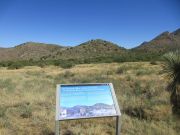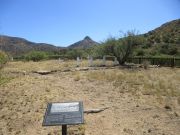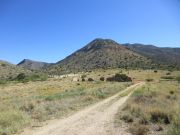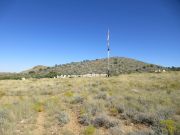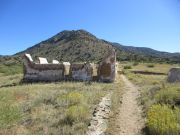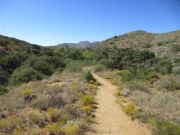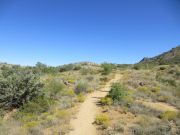
The Mountains of Arizona
www.surgent.net |
|
Peak 5112 • Peak 5381 Today I would venture to Fort Bowie National Historic Park, where Fort Bowie was established in 1862 as the central point in what would be a 25-year war against the Apache, known collectively as the Apache Wars. These wars and battles pitted the various bands of the Apache, mainly the Chiricahua band led by Mangas Coloradas, Vittorio and Cochise, then later, by Geronimo, against the United States Military. Fort Bowie lies in Apache Pass, which is essentially where the Chiricahua Mountains and the Dos Cabezas Mountains meet, the Chiricahuas to the southeast, the Dos Cabezas to the northwest. Apache Pass was critical as it was one of few feasible ways to pass through these mountains, which together run about 60 miles in length. It was (and still is) the location of Apache Spring, one of very few water sources in the whole region. The Apache were not one massive civilization of Indians but instead a smattering of smaller bands that generally left one another alone, except when they fought. These smaller bands could move about easier with the seasons. They farmed, hunted and lived off the land, but they also fought one another, and the Mexicans, engaging in cattle rustling and thievery. The United States was not much of a factor until just after the end of the Mexican-American War (1849), in which much of norther Mexico now came under United States' jurisdiction. In 1853, the Gadsden Purchase added more land from Mexico to the United States, including much of this area. This was important because it allowed for horse and rail routes from the east out to California. For the most part, the Apache were content to ignore the American intrusion, and even in some cases, acted as allies or at least were generally helpful, because the Apache still pointed most of their energies toward the Mexicans. To use a term from today, as long as the Americans didn't interfere with the Apache's rackets, the Apache would leave the Americans alone. There were various forts and posts set up in the American Southwest (Arizona did not yet exist at this time; this was all still New Mexico Territory). The American military presence was here largely to ensure the peace for the few settlers in the region, those travelling to and from California, and handling the occasional Indian skirmish. There are too many people, too many moving parts, to explain all this properly. By the early 1860s, the Civil War was gearing up. Suddenly, both the United States and the Confederate States had eyes on the region for its mineral riches. This added a wrinkle to how the military was used out here. Not everyone saw eye to eye. The Americans were suddenly split into two factions and many were eager to head east and fight in the Civil War, where they had stakes such as land and family history. It was in 1862 that the Apache Indians, mainly the Chiricahua band, became enemies of the United States, after an incident involving a raid on a ranch, a kidnapping, and a directive to get the child back by any means possible, which, not surprisingly, went off the rails fast. This is known as the Bascom Affair and I have a link to it below. The wars that followed, until Geronimo was captured and exiled, were the last of the Indian wars. Once these wars ended in 1890, that was the end of all Indian battles. I have been reading up on the Apache Wars and the history of the region since moving to Bisbee. I was surprised how little I actually knew. It cannot be distilled into "good guys and bad guys". Both sides acted treacherously against one another. Both sides had good guys and bad guys. I still continue to read what I can. The more I read, the more fascinating it becomes. I have been interested in revisiting Fort Bowie, which is now a National Historical Park, since moving to Bisbee. I wanted to hit up a couple of easy peaks while here, and saw two that straddle Apache Pass, as good targets. I did not want all-day epics. I wanted a couple that could be done in a few hours, leaving time to hike out to the actual Fort Bowie. So my alarm goes off early in the morning and I turn it off and go right back to sleep. A couple hours later I wake and feel bummed that I missed out on today's adventure. I moped around for an hour and decided that the weather, while warm, should still be amenable to some hiking. It's not blazing hot like it has been all summer. In fact, today was the first day of autumn. I left the house at 9 a.m. and drove through Elfrida and routes US-191, AZ-181 an AZ-186 to get to the road that leads in toward Fort Boiwe. This is along AZ-186 about nine miles nothwest from where AZ-181 and AZ-186 diverge. Today was beautiful, with blue skies and no clouds. Even at 10 a.m., it was still in the low 70s outside. Apache Pass is a natural divide between the two ranges. Peak 5112 lies north of the pass, north of the trailhead parking for access to Fort Bowie itself. Peak 5381 lies due east of Peak 5112, but south and east of the pass. In my opinion, Peak 5381 is in the Chiricahua Mountains, while Peak 5112 would be in the Dos Cabezas Mountains. Neither peak sees many visitors. Lists of John showed three previous ascents of Peak 5112, and just two for Peak 5381. They're not difficult to climb, but they are remote. Their summit elevations and prominence values are derived from the 1-meter Lidar datasets and used here. I rolled into the small parking area at the Fort Bowie Trailhead at 10:20 a.m., the only one here. Peak 5112 rose directly above me to the north.
Date: September 22, 2024
• Elevation: 5,112 feet ✳
• Prominence: 339 feet
• Distance: 0.6 mile
• Time: 45 minutes
• Gain: 362 feet
• Conditions: Sunny, blue skies, slightly warm
Arizona
•
Main
•
PB
•
LoJ
•
Lidar
The slope looked open with low brush, but to be safe, I wore jeans and my snake gaiters. I scampered up the steep road cut to get on the slopes, then just started walking uphill, angling a little to ease the gradient.
I soon came upon the boundary fence for the Fort Bowie Park. I was able to step over it. Fortunately, the top wire strand was not barbed. Once above that, I continued the slow walk up until the grade levelled.
I was now on the short summit ridge. I could see the summit bump up ahead, a few feet higher than the other bumps. The brush here was open and there was a path for a little ways. Suddenly, I was at the highpoint.
The one-way hike took just 20 minutes. The top is rocky and I found a cairn and a lid to a jar, suggesting a register bottle. However, I could not find the register itself. I spent a minute or two shooting images. The views were good. I had an elevated view of the cemetery of Fort Bowie, also the road wending through Apache Pass, and to the northwest, big Government Mountain.
The downhill hike went well. The slopes are covered in small angular rocks that slide and don't consolidate. I had to move slow to avoid slips. Lower down, I found an open spot to squeeze under the fence, then found a better slope back to the road and my car. The round trip took just 45 minutes. By now, another car had rolled in and they looked ready to be hiking to Fort Bowie.
Elevation: 5,381 feet ✳
• Prominence: 379 feet
• Distance: 2.6 miles
• Time: 90 minutes
• Gain: 840 feet
• Conditions: Sunny and warm
PB
•
LoJ
I got in my car and drove northeast on Apache Pass Road, losing a couple hundred feet of elevation. I got to where the road parallels Siphon Canyon, the peak right there across the way, the top less than a mile distant on a straight line.
It became clear that the two ridges closest to the road were not good options. They had too many rocky sections, and getting to their base would mean battling some nasty trees and brush growing within the creek bottom of Siphon Canyon.
I drove back and forth along the road inspecting the other ridges. The southernmost ridge looked promising. Now, where to park. There are no pullouts here. I stashed my car along the road at a bend where it would be visible from both directions. The road is easily wide enough for two vehicles. Traffic is very light here.
The next challenge was where to drop off the road and into the creek bottom. The grader over the years has created a substantial berm that drops about ten feet straight down the other side into the creeks. Other sections were choked in heavy brush and trees. I found a spot and eased down the rocks, and was now in the sandy creek bottom. Here, the bottoms are coarse sand and about twenty feet wide.
To be honest, I was losing the spirit fast for this hike. All the futzing around for a place to park and then to get into the creek bottom took about twenty minutes. It was much warmer and I wasn't sure this was worth it.
I figured I'd hike south into the main part of the canyon toward the Tevis Rocks, as mentioned on the maps. The walking went well. I had to crawl under the park boundary fence here. I got to the Tevis Rocks but they weren't anything unique, just some mildly interesting formations in a few spots.
I started up that southern ridge. It was brushy and rocky, but the slope had a nice grade to it, and I could usually see my feet. As I ascended, I studied the parallel ridge, one with a more southwesterly angle to it. It looked friendly, but had one section of exposed sloping rocks that could be trouble.
The uphill was steep and laborious but not difficult. I gained about 450 feet, following a fence line much of the way. I then sidehilled around a hill to place myself on the southern ridge of the peak. The brush changed quickly, from leafier small trees and bushes to scanter grasses and thick ocotillo. All the while I studied that southwestern ridge. Those rocks from this angle didn't look so bad. I decided I'd take that ridge on the descent.
The southerly ridge also had its rocky section but they leaned back well and required no hands. Otherwise, it was mostly-open trudging through scattered low brush and ocotillo, aiming for the highest point ahead.
This was not yet the summit. The summit ridge is short (about 200 yards) with three bumps. The map says the north one is highest, but my eyes said the middle one looked higher. I hiked to all three bumps, tagging the highest rocks at each. According to Lists of John, I was the third visitor to this peak, the first since 1995. I could find no register nor cairns, and it may be true that no one ever comes up here. The views were nice, that was a bonus.
It had taken me a little under an hour and I was feeling fatigued from this hike. I later determined I gained about 840 feet. I was not expecting this peak would require so much effort. I'm glad I hiked it, but I didn't celebrate. I turned around and started the walk down.
I followed the southwesterly ridge, which worked well. When I got to the rocks, I picked a line down and followed it until the slope or cliffs stopped me. Now up close and intimate with these rocks, I could see ways down, but it appeared I had no choice but to take some of it on my butt and use the hands as well. It wasn't cliffy, but it sloped severely. This only went for about twenty feet. Going up, I'd rate it Class 2+.
Once below the rocks, I made good time down the slopes back into the creek bed, then followed it out back to my car. I had been gone 90 minutes, and the descent ridge probably saved me twenty minutes of time. It was a tiring hike and nothing memorable. It occured to me that both of these peaks, with their fine views from the tops, would have been natural places to scout. I would not be surprised if the Apache and/or the U.S. Military sent guys up to these peaks to keep an eye out for trouble.
Back in my car, I drove back to the parking lot at the Fort Bowie Trailhead.
After my two peak hikes, I was still keen to visit the actual Fort Bowie site. It was 1:30 p.m. now and warm, in the low 80s. Signs at the trailhead say it's 1.5 miles to the main site, with some ruins along the way.
I started walking, the trail being wide and well maintained. It runs with the lay of the land, going into and out of many small arroyos and over small ridges, but for the most part, is level. There is a gentle upward gradient overall in the 1.5 miles.
My wife and I were here in 2003, but I don't remember if we walked to the actual site. I thought my memory may be jogged as I came upon each of the ruins but no, that didn't happen. We probably didn't do the walk.
Since moving to Bisbee and learning more about the Apache Wars, my interest in this site, and surrounding sites with a similar historical interest, has been growing. It feels more tangible to be standing on or near the actual site of a major battle, once you have an overall sense of the timeline.
One of the first sites is just a field, but it was the location of the "Bascom Affair", or more commonly known as the "Cut the Tent" incident. It was this incident that essentially started the Apache Wars that would persist for over 25 years, until 1890. It is too difficult to summarize in a few sentences. This site has a good summary, and the Wikipedia site also summarizes the incident well.
The trail crosses a few more sites and low ruins, such as the stage stop. It bypasses a cemetery, then drops into a draw. It passes by the Battle of Apache Pass, fought in 1862. Again, I can't do it justice in a few sentences. Moments later, the trail enters into a tiny but lush patch of forest, this being Apache Spring, one of very few water sources back then or even now. It is understandable why this spring and pass were so critical to both the Apache and the United States military during this time.
Soon, I was approaching the main grounds, which sit in a sloping plain. I first stopped into the visitor's center, where I spoke briefly with the young woman working there today. I was the only one here. There was a guy earlier walking out as I walked in; we passed eachother near the cemetery.
I then walked the grounds, going from building to building, which these days are mere foundations, or low walls of adobe. Some of the information signs have photos from back then showing how the area looked when everything was intact.
This is a remote part of Arizona and still a harsh place, one can only imagine being here in the 1860s-1880s. The Apache Wars were a complex series of battles and standoffs that are as complex in terms of strategy that simply cannot be summarized neatly in such a short space. I encourage you to read up on it. It makes everything make more sense once you understand who was involved and why. The end of the Apache Wars essentially was the end of the "Old West".
I spent about half hour walking the grounds, but I was growing tired and weary, and figured I better get a move on while I could still actually move. The hike out went well, where I could descend slowly, back to my car. It was now 3 p.m., and I had had a full day. The peak hikes were fun, but combining it with a visit to Fort Bowie was especially meaningful. With some better understanding of the Apache Wars, I can better appreciate visiting these places and contemplating the events that occurred here. I drove out the same way back to AZ-186, then the same route back home, with a drink stop in Elfrida. I was home by 4:30. |
|


















